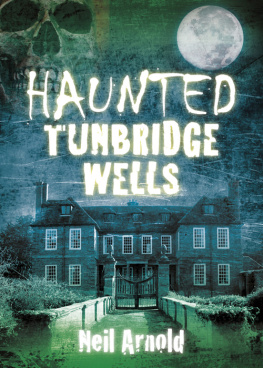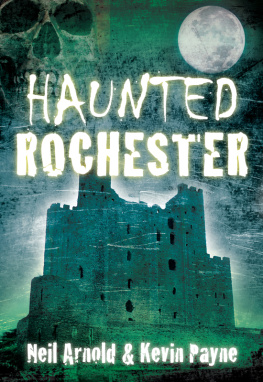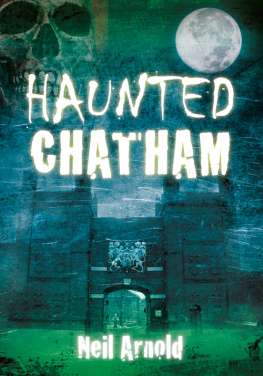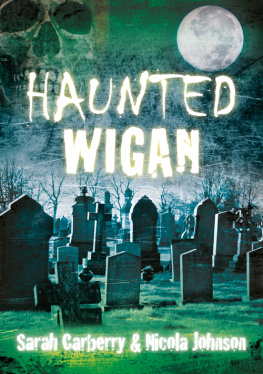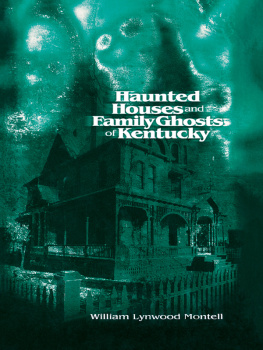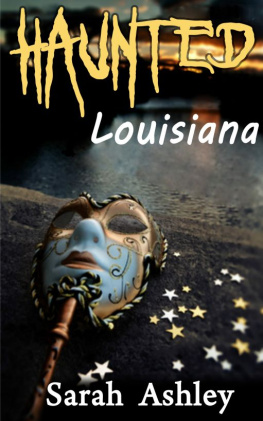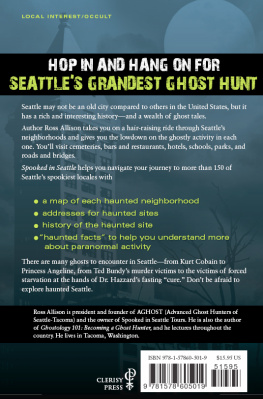This book is dedicated, with love, to Susie, Bob, Charlotte and Sam
Contents
Its the unseen hand that slips into your own
The non-specific presence that drifts through the home,
A shiver down your neck when theres nobody there;
The slamming of a door and the creak on the stair.
Its the tap on the window, just a branch in the wind?
The drip of a tap into the dry bowl of the sink,
In darkness, in light and beyond comprehension,
To shatter the nerves and grip us with tension.
M ANY thanks to the following for help and support whilst writing this book: my parents, Ron and Paulene; my sister, Vicki; my wife, Jemma (thanks for the surreal road trip!); my nan, Win; and granddad, Ron; James Mitson; Christopher Cassidy; Susie Higgins and Soul Searchers Kent; John Vigar; Charles Igglesden; Andrew Green; Sean Tudor; The Why Files; The History Press; Francies Moore; Peter Underwood; Joe Chester; Kent Messenger; Tunbridge Wells Library; English Heritage; Sean Croucher; Steve Baxter; all the pub landlords and staff who I spoke to; Medway Archives; Bygone Kent; BBC News; the Telegraph; This is Kent; Ludington Daily News; the Kent and Sussex Courier; Tunbridge Wells Tourist Information Centre; and all the witnesses who came forward to report their experiences.
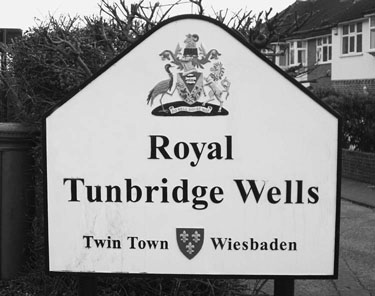
No county in England can boast so many mysterious figures of the night as the Garden of England. Sober citizens of its cities, towns and villages are all speaking of spirits they have seen in dark country lanes, unfrequented passages, in the grounds of old mansions, and in the mansions themselves.
The Leader Post, 1 July 1935
Its the man dressed in black and the woman in white
Or a child dressed up for a Halloween fright.
Its the campfire crackle and the hoot of an owl,
A phantom coach and horses, spectral monk in black cowl.
R OYAL Tunbridge Wells (according to the website Visit Tunbridge Wells) was the place to see and be seen amongst royalty and the aristocracy.
For more than 400 years the town has been popular with visitors, who, since the early seventeenth century, have flocked to savour the healing properties of the chalybeate (pronounced ka-lee-bee-at) spring which was discovered by Lord Dudley North in 1606. The magical waters can be experienced up to this day, and are served by a dipper dressed in appropriate costume. The iron-rich properties are said to cure all manner of ailments and diseases, as well as hangovers and infertility. The website adds: Word of the new spring and its special properties soon spread, and visitors from London and elsewhere flocked to the small settlement which developed alongside the Spring and later became known as Tunbridge Wells.
The spring has a characteristic red colour, and is slightly warm. One legend states that, many years ago, the Devil, whilst pestering Sussex, was sent packing by St Dunstan: he clamped the Devils nose with a set of blacksmith tongs and made the horned one flee to Tunbridge Wells where he proceeded to dip his burning nostrils into the cool waters for relief. A less dramatic version of events claims that St Dunstan, in order to cool his red-hot tongs, walked to Royal Tunbridge Wells and plunged them into the spring.
Imagine the scene, some three or more centuries ago, when aristocracy would visit the wells for a morning sip of spring water and then be on their way to the decorative promenade. During the Georgian period Tunbridge Wells became a popular spa resort. Today it is lined with coffee houses, bars, and the like, and, for a relaxing day, one can still pretend to be a dandy from days of yore and soak up the atmosphere of the place. Like the town of Rochester and the city of Canterbury, Tunbridge Wells is atmospheric in its antiquarian glamour. From the old creaking buildings to grand family houses boasting stunning architecture, the town is rich in history. The year 2009 served as the 100th anniversary of Tunbridge Wells as a Royal town. The town achieved its title in 1909 when King Edward VII, impressed by the town as an attraction to aristocratic visitors, granted the prestigious honour.
Royal Tunbridge Wells sits at the northern edge of the High Weald. Almost 60,000 people reside in the town, though Tunbridge Wells isnt without its green spaces: the town is surrounded by dense woodlands, spacious commons and rolling fields. Dunorlan Park stretches for almost 80 acres and Bedgebury Forest which slips into Goudhurst, Hawkhurst and Flimwell is an ancient woodland that takes up some 2,600 acres. It forms part of the High Weald Area of Outstanding Natural Beauty. The former is mentioned in the Anglo-Saxon charter of AD 841. In his Account of the Weald of Kent, from 1814, T.D.W. Dearn writes that the town, [is] a large and populous hamlet lying in the several parishes of Tunbridge, Speldhurst, and Frant, at the distance of 36 miles from London. He adds that it is divided into four districts: Mount Ephraim, Mount Pleasant, Mount Sion and The Wells.
In 1956 the town suffered a bizarre summer ice storm. The August Bank Holiday Monday tranquillity was disturbed by a barrage of hail which left the streets of Tunbridge resembling Arctic tundra or, as the local newspaper put it, like a rice pudding spreading throughout the town. So severe was the storm that the rooftops of some buildings collapsed due to the weight of ice. Even more bizarre was the fact that at Tonbridge, just 5 miles away, locals enjoyed the sun and were completely unaware of the freak storm that had hit their neighbours. The severity of the storm echoed a destructive tornado scare which struck Tunbridge Wells in 1763. Pembury and Paddock Wood were caught in the path of the 5-mile wide phenomenon trees were uprooted from the ground, houses were crushed and animals were battered to death by the enormous hailstones.
I write this as a brief blanket of Kentish snow begins to thaw, and at night the shadows play tricks on the mind as they are cast long across the pristine white by stark, reaching trees. The wintertime is perfect for ghost stories such tales seem to lack atmosphere when told during a bright summery day! Around the festive season, into the months of a new year, the countryside is crisp, and early morning jaunts bring swirling marsh mists and dew-damp fields; as the curtain of dusk falls, nature comes alive and the senses are heightened.
Royal Tunbridge Wells and the surroundings villages confined within the district are full with ghost stories, perfect for a moonlit night. Its no surprise. Pick up a majority of ghost books pertaining to Kent and youll read about a handful of local spectres, especially those said to haunt the Pantiles a beautiful walkway ideal for shopping and relaxing. These ghost stories are relatively well known, almost to the extent that they compete with the village of Pluckley situated near Ashford for the title of Kents most haunted location. Over the last few decades a number of researchers have looked into some eerie Tunbridge Wells yarns, and a few are mentioned here, but my aim is to uncover a new wealth of spooky occurrences the more obscure, the better! These tales stretch back many years, and many appear here for the first time though certain ghostly tales, of course, cannot be avoided: they are embedded in the framework of those old buildings. And yet there will be other yarns less well-known, from tales of hideous ghost hounds and other supernatural beasts to haunted castles and creepy roads all perfect fodder for a cosy night by that crackling campfire. This book is by no means an exhaustive catalogue of Tunbridge Wells levels of high strangeness, as there are so many weird stories to relate, but it is a selection of my favourite ghostly tales from the town and its surrounding villages.
Next page
